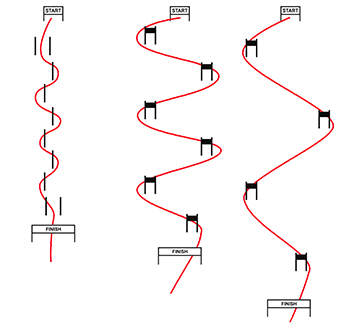Disciplines of Alpine Ski Racing
Slalom (SL) –
Slalom is a timed event requiring the execution of many short, quick
turns through two different courses. The slalom features the shortest
course and quickest turns. As in the giant slalom, each skier makes two
runs down two different courses on the same slope. The competitors are
required to pass between all the gates, alternate red/blue pairs of
poles. Both runs take place on the same day. The times are added
together, and the fastest total time determines the winner.
Giant Slalom (GS) –
Giant slalom is characterized as the discipline that requires the most
technical skill: skiers race down the mountain through a faster and more
open course than in Slalom. Giant slalom is similar to the slalom, with
fewer, but wider and smoother turns. Each skier makes two runs down two
different courses on the same slope. Both runs take place on the same
day, usually with the first run held in the morning and the second run
in the afternoon. The times are added together, and the fastest total
time determines the winner. Super-G (SG) –
Super G (super giant slalom) combines the elements of speed from the
downhill, while integrating high speed technical turns from the giant
slalom. The course is shorter than downhill but longer than a giant
slalom course. Each skier makes one run down a single course and the
fastest time determines the winner. |  |